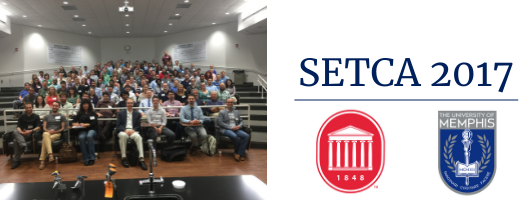Location
Coulter Hall, Room 211
Start Date
19-5-2017 4:00 PM
End Date
19-5-2017 4:30 PM
Description
Developed during the last decade by Ruscic and collaborators at Argonne National Laboratory, Active Thermochemical Tables (ATcT) represents an entirely new and revolutionary way to approach the subject of thermochemistry. Traditional thermochemistry has advanced piecemeal and willy nilly, through individual spectroscopic, kinetic, calorimetric, etc. mea-surements often supplemented by 'recommendation of 'standard (in the non-thermodynamic sense) through the actions of various critical review committees (NIST-JANAF, CODATA, etc.). In contrast, ATcT is a holistic approach that views each molecule as connected in principle to all other species through within constructs called thermochemical networks. In ATcT, thermochemical parameters such as bond energies, ionization potentials, and en-thalpies of formation are solved for self-consistently using all available relevant information. Many bond energies once known to, say, a few kcal mol-1 have now been established with aprecisionthatis atleastanorderofmagnitudebetterthan before, whichclearlyhas enormous practical consequences for modelling studies. This talk reviews the surprisingly interesting topic of where do these heats of formation come from? and outlines the basic ideas in ATcT. Due to the high interconnectedness of many chemical species through the thermochemical network paradigm, it transpires that knowing any individual property (say, an ionization potential) can potentially impact properties of any number of different species. Hence, there is virtue to constantly improving our knowledge of fundamental molecular prop-erties that goes well beyond just putting another decimal place on it. ATcT actively seeks accurate measurements and calculations for key quantities, which will be illustrated by a recent study of the photoelectron spectrum of hydrogen peroxide.
Relational Format
Conference proceeding
Recommended Citation
Stanton, John F., "IL9. Thermochemistry: Not as Boring as You Might Think" (2017). Southeast Theoretical Chemistry Association Meeting (SETCA). 18.
https://egrove.olemiss.edu/setca/2017/schedule/18
IL9. Thermochemistry: Not as Boring as You Might Think
Coulter Hall, Room 211
Developed during the last decade by Ruscic and collaborators at Argonne National Laboratory, Active Thermochemical Tables (ATcT) represents an entirely new and revolutionary way to approach the subject of thermochemistry. Traditional thermochemistry has advanced piecemeal and willy nilly, through individual spectroscopic, kinetic, calorimetric, etc. mea-surements often supplemented by 'recommendation of 'standard (in the non-thermodynamic sense) through the actions of various critical review committees (NIST-JANAF, CODATA, etc.). In contrast, ATcT is a holistic approach that views each molecule as connected in principle to all other species through within constructs called thermochemical networks. In ATcT, thermochemical parameters such as bond energies, ionization potentials, and en-thalpies of formation are solved for self-consistently using all available relevant information. Many bond energies once known to, say, a few kcal mol-1 have now been established with aprecisionthatis atleastanorderofmagnitudebetterthan before, whichclearlyhas enormous practical consequences for modelling studies. This talk reviews the surprisingly interesting topic of where do these heats of formation come from? and outlines the basic ideas in ATcT. Due to the high interconnectedness of many chemical species through the thermochemical network paradigm, it transpires that knowing any individual property (say, an ionization potential) can potentially impact properties of any number of different species. Hence, there is virtue to constantly improving our knowledge of fundamental molecular prop-erties that goes well beyond just putting another decimal place on it. ATcT actively seeks accurate measurements and calculations for key quantities, which will be illustrated by a recent study of the photoelectron spectrum of hydrogen peroxide.



Comments
Download includes an expanded abstract with collaborators, institutional affiliations and cited references.